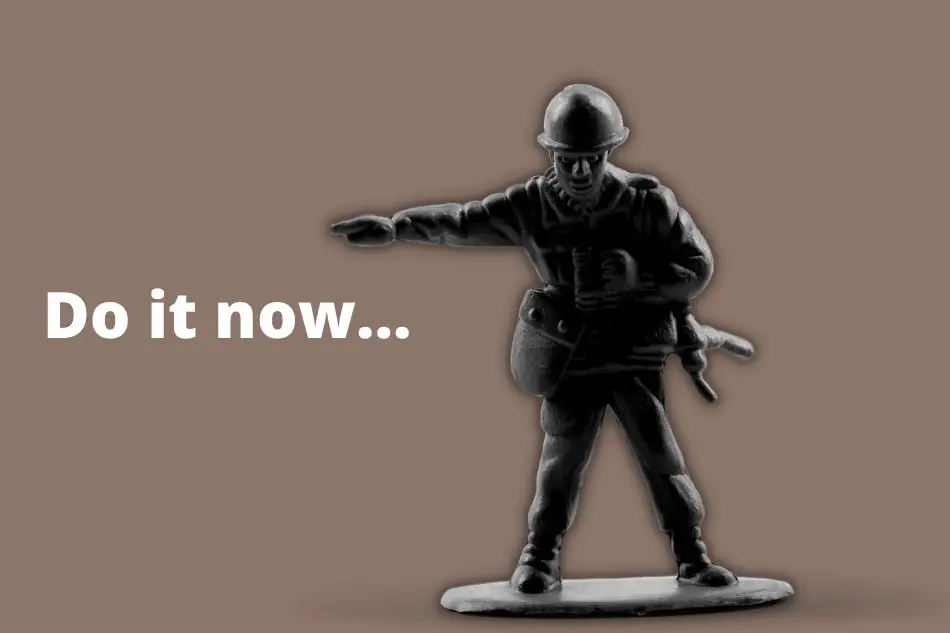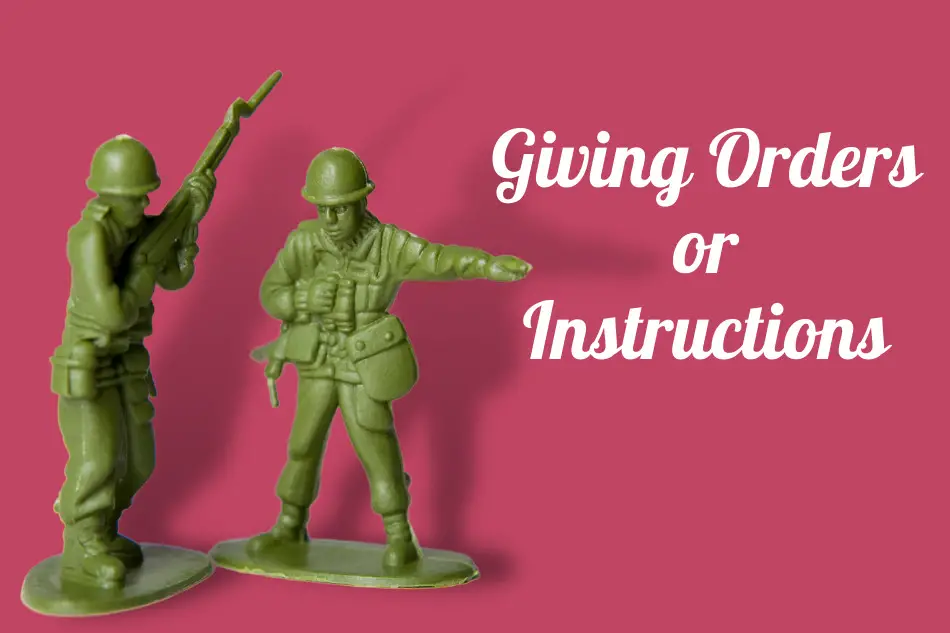In our everyday life, we need to ask people around us to do something, either in the form of orders, instructions, requests, or suggestions. Sometimes, we face difficulties providing clear instructions due to not knowing appropriate English expressions. The way we order someone to do something may sound rude and inappropriate to people if we don’t know how to do it politely.
In this post, I’ll discuss some expressions you can use to give orders and instructions in English in your everyday life.
Generally, in informal situations, we give orders or instructions with imperative expressions, whereas in formal cases, we ask someone to do something indirectly using modal verbs rather than giving them direct order. However, using “please” or “let’s” while giving orders or instructions may help soften your expression and sound politer.
Are you looking for a book or a guide to help you learn and improve your English? You may try English Made Easy Volume One: A New ESL Approach: Learning English Through Pictures (Amazon Link).
Table of Contents
- Giving Orders or Instructions Using Imperative Sentences
- Giving Orders or Instructions Using Modal Verbs
- Giving Orders or Instructions Indirectly
- Giving Orders or Instructions Using Ordinal & Connecting Adverbs
- Giving Orders or Instructions Using Question Tag
- A Sample Conversation on Giving Orders or Instructions
- Takeaway Words
- In Conclusion
- 10 Frequently Asked Questions Related to Giving Orders or Instructions in English
A comparison table shows different ways of giving the same orders or instructions.
| Imperative sentences to give orders or instructions (Direct & Casual) | Sentences with “Please” to give orders or instructions (Polite & Formal/Casual) | Sentences with “Let’s” to give orders or instructions (Polite & Formal/Casual) | Sentences with modal verbs to give orders or instructions (Polite & Formal) |
| Call them now. | Please call them now. | Let’s call them now. | Can you call them now? |
| Go back there. | Go back there, please. | Let’s go back there. | Could you go back there? |
| Do it now. | Please do it now. | Let’s do it now. | Can you do it now? |
| Help him. | Help him, please. | Let’s help him. | Will you help him? |
| Sit down here. | Sit down here, please. | Let’s sit down here. | Would you sit down here? |
Giving Orders or Instructions Using Imperative Sentences

The most common way to give orders or instructions is by using imperative sentences. Besides, we also use imperative expressions to make requests, give proposals, and encourage someone.
Imperative sentences usually begin with a verb, and in most cases, the grammatical subject is not visible in the sentence. We can have imperatives in both affirmative and negative forms. The negative imperative sentences typically begin with “Don’t” or “Do not.”Let’s see some examples.
Examples of Affirmative Imperative sentences to Give Orders or Instructions
- Wait.
- Stand up.
- Pass the curry.
- Call him right now
- Go to the other room.
- Send me the e-mail as soon as possible.
Examples of Negative Imperative Sentences to Give Orders or Instructions
- Don’t go outside.
- Do not go there alone.
- Don’t accept the proposal
- Don’t kick the ball in this way.
- Don’t talk too loudly in this room.
- Do not send anyone any product without my consent.
From the above examples, we can clearly understand the structure and purpose of imperative sentences. All the sentences have no visible subject. However, you can imagine the subject “you” at the beginning of such sentences, which will still be meaningful. For examples:
- [You] take it.
- [You] come with me.
- [You] submit the proposal.
- [You] send me the previous schedule.
Giving Orders or Instructions Using “Let’s” with Imperatives

Notice minutely. All the examples given as imperative sentences above have the subject, 2nd person “you.” There is no involvement of the speaker, 1st person, “I.”
However, you can also involve the speaker in the order or instructions by using “Let’s.” Here are some examples.
- Let’s take him with us.
- Let’s complete the assignments now.
- Let’s bake a chocolate muffin cake together.
- Let’s watch the remaining episodes of the series.
Note: All the imperative sentences are usually in the present simple form. We ask someone to do something in the current time, though they may do it now or later. And remember! We use such plain imperative sentences in casual/informal situations.
In the later part of the post, we will look at some polite expressions used to give orders or instructions in formal situations.
Giving Orders or Instructions Using “Please” with Imperatives

As imperative sentences are direct orders or instructions, they may sound rude to many people. So, it would be best to soften your expression while giving orders or instructions.
However, simply putting a “Please” at the beginning or end of any imperative sentence may help sound politer. It’ll undoubtedly sound better and more convincing as well as you can use it in formal situations.
- Please talk to him immediately.
- Leave the document here, please.
- Please send him the message as early as possible.
- Go and bring something for me to eat, please.
Giving Orders or Instructions Using Modal Verbs

To give orders or instructions to someone, we can use modal verbs to sound polite. Once you use modal verbs to give orders, it may sound like you are making a request or offering something, though originally it’s an order.
People will usually not reject you if you ask someone to do something politely. And no matter whether you are in a formal or casual situation, politeness is the key. Let’s see some example sentences of orders and instructions using modal verbs.
- Can you do it now?
- Would you go there?
- Will you stop?
- Could you make a cup of tea for me?
- It will help if you go there.
- It would be best if you could do it for me.
- I was hoping you could complete the assignment by tonight.
Though the above sentences are in the form of questions, they are orders in the disguise of requests. Don’t they sound better than the imperative sentences?
Giving Orders or Instructions Using “Please” with Modals
We know that modals can help sound polite while asking someone to do something. Well! You can sound even politer by putting a “please” with modals while giving any orders or instructions. For example:
- Would you please send the e-mail to HR?
- Could you please get something for me to drink?
- Can you please tell him to call me?
- Will you please come here at once?
- Would you please place the table here?
Note: “Could” and “Would” are more formal than “Can” And “Will.”
Giving Orders or Instructions Indirectly
Being very direct may sound harsh while giving orders or instructions. You can use some indirect approaches to get something done by someone. Here are some examples. If you know some more expressions like them, you can share them in the comment box to help others learn.
- If you have some time on your hand, the committee wants you to stay.
- I would like to have you help me with the project.
- If possible, collect all the bills by tomorrow.
- Is it possible to finish the presentation in 15 minutes?
- Is there any way out of hiring a car now?
- Is it ok if you are given the responsibilities of another department?
- Do you think you can make all the arrangements by yourself?
Giving Orders or Instructions Using Ordinal & Connecting Adverbs

While giving someone instructions or directions, you can use ordinal adverbs. It’ll help the person to follow the sequence. You can also use connecting adverbs to bring together different steps. Use of words like “first,” “secondly,” “in the beginning,” “then,” etc., helps a lot, mainly when you describe a process.
Here are some examples.
- Remove the wire first. Place the monitor then.
- Firstly, call Riyad and seek permission to open it.
- Don’t go for desserts in the beginning. Have some appetizers first.
- Do it at the end. Not now.
Giving Orders or Instructions Using Question Tag
One very common way of giving orders or instructions is using a question tag. This type of sentence helps you give order or instruction and get the listener’s consent. You can get to know whether the person is ready to follow your order or not. Let’s see some examples.
- Cook something for us, will you?
- Sing that song for us, can you?
- Don’t go there again, will you?
- You take him to school, will you?
- Take good care of her, won’t you?
A Sample Conversation on Giving Orders or Instructions
Event Manager: Hello, Good Morning! Dream Events – How may I help you?
Ashton: Hi there. This is Ashton from Smallville. I’m planning to throw a party for my sister’s birthday next week. I need a good place and some nice arrangements.
EM: You’re at the right place, sir. Is it going to be a big party?
Ashton: Oh, not really… We may call roughly thirty people. Would you suggest something for that, please?
EM: Of course. We have a lovely place for family parties and ceremonies. We can arrange cozy sittings for your guests. The room has an AC… so no sweats.
Ashton: What about decoration? Please, make sure there are no foam sprays… My mom’s allergic to that.
EM: I’ll keep that note. However, we can provide you with both simplistic and vibrant decorations – whichever you like.
Ashton: Well, my sis loves colors, so I’ll choose a top-end decoration for her.
EM: Awesome. Would you bring the food yourself, sir? We have a…
Ashton: Oh no, please, don’t bother. I’ll take care of that. Just gimme a hygienic space where I can keep them before the party starts.
EM: No worries. We have a nice pantry where you can keep your ordered food… Uh oh… what about the cake? Are you bringing it as well?
Ashton: Sure. I’ve already ordered it. Now, send me a bill to this email address, so I can make an advance, will you?
Takeaway Words
Roughly (adverb) = not precisely or specifically
Cozy (adjective) = being comfortable
Vibrant (adjective) = very colorful or consisting of too many bright colors
Top-end (adjective) = something of a high quality
Hygienic (adjective) = free of germs, dirt, or pollution
Pantry (noun) = a place where one can store food items
In Conclusion
Whether you are an office boss or a team leader, you are expected to ask people to do something rather than ordering them. Your polite expressions may motivate your juniors and help boost them up.
While giving orders or instructions, you should maintain a polite tone and body language besides good expressions.
Thank you!
10 Frequently Asked Questions Related to Giving Orders or Instructions in English
1. Is there a difference between giving orders and giving instructions?
Yes. Orders are more direct and authoritative, while instructions provide a detailed step-by-step guide on how to do something.
2. How can I give clear instructions?
Be specific, use simple language, and break down the task into manageable steps. It’s also helpful to check for understanding by asking the person to repeat back what they’ve heard.
3. Is it okay to use imperatives when giving orders?
Yes, imperatives are often used when giving orders, e.g., “Close the door,” “Sit down.” However, tone and context are essential to ensure you don’t come off as rude.
4. How can I ensure that my instructions are understood?
After giving instructions, ask the person to summarize what you’ve said or ask if they have any questions.
5. What are some polite phrases I can use when giving orders?
Phrases like “Could you,” “Would you mind,” or “Please” can soften the command, making it sound more like a request.
6. Is body language important when giving instructions?
Absolutely. Positive and open body language can make the receiver more receptive. Using gestures can also help clarify your instructions.
7. How should I handle someone not following my instructions?
Address the situation calmly, ask if they understood the instructions, and offer to clarify any confusion.
8. Are visual aids helpful when giving instructions?
Yes, diagrams, charts, or any visual representation can make instructions clearer, especially for complex tasks.
9. Is the sequence important when giving instructions?
Yes, always provide instructions in the order they need to be executed to prevent confusion.
10. How can I improve my skill in giving instructions?
Practice is key. Also, seeking feedback from those you instruct can provide insights into areas of improvement.






2 thoughts on “How to Give Orders or Instructions in English”